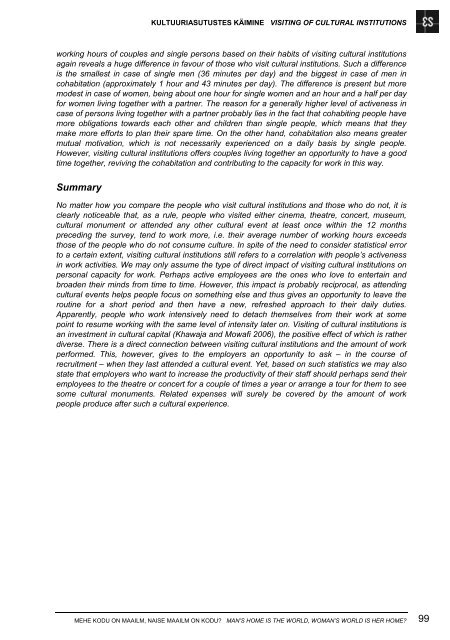MEHE KODU ON MAAILM, NAISE MAAILM ON KODU? - Tartu Ãlikool
MEHE KODU ON MAAILM, NAISE MAAILM ON KODU? - Tartu Ãlikool
MEHE KODU ON MAAILM, NAISE MAAILM ON KODU? - Tartu Ãlikool
You also want an ePaper? Increase the reach of your titles
YUMPU automatically turns print PDFs into web optimized ePapers that Google loves.
KULTUURIASUTUSTES KÄIMINE VISITING OF CULTURAL INSTITUTI<strong>ON</strong>S<br />
working hours of couples and single persons based on their habits of visiting cultural institutions<br />
again reveals a huge difference in favour of those who visit cultural institutions. Such a difference<br />
is the smallest in case of single men (36 minutes per day) and the biggest in case of men in<br />
cohabitation (approximately 1 hour and 43 minutes per day). The difference is present but more<br />
modest in case of women, being about one hour for single women and an hour and a half per day<br />
for women living together with a partner. The reason for a generally higher level of activeness in<br />
case of persons living together with a partner probably lies in the fact that cohabiting people have<br />
more obligations towards each other and children than single people, which means that they<br />
make more efforts to plan their spare time. On the other hand, cohabitation also means greater<br />
mutual motivation, which is not necessarily experienced on a daily basis by single people.<br />
However, visiting cultural institutions offers couples living together an opportunity to have a good<br />
time together, reviving the cohabitation and contributing to the capacity for work in this way.<br />
Summary<br />
No matter how you compare the people who visit cultural institutions and those who do not, it is<br />
clearly noticeable that, as a rule, people who visited either cinema, theatre, concert, museum,<br />
cultural monument or attended any other cultural event at least once within the 12 months<br />
preceding the survey, tend to work more, i.e. their average number of working hours exceeds<br />
those of the people who do not consume culture. In spite of the need to consider statistical error<br />
to a certain extent, visiting cultural institutions still refers to a correlation with people’s activeness<br />
in work activities. We may only assume the type of direct impact of visiting cultural institutions on<br />
personal capacity for work. Perhaps active employees are the ones who love to entertain and<br />
broaden their minds from time to time. However, this impact is probably reciprocal, as attending<br />
cultural events helps people focus on something else and thus gives an opportunity to leave the<br />
routine for a short period and then have a new, refreshed approach to their daily duties.<br />
Apparently, people who work intensively need to detach themselves from their work at some<br />
point to resume working with the same level of intensity later on. Visiting of cultural institutions is<br />
an investment in cultural capital (Khawaja and Mowafi 2006), the positive effect of which is rather<br />
diverse. There is a direct connection between visiting cultural institutions and the amount of work<br />
performed. This, however, gives to the employers an opportunity to ask – in the course of<br />
recruitment – when they last attended a cultural event. Yet, based on such statistics we may also<br />
state that employers who want to increase the productivity of their staff should perhaps send their<br />
employees to the theatre or concert for a couple of times a year or arrange a tour for them to see<br />
some cultural monuments. Related expenses will surely be covered by the amount of work<br />
people produce after such a cultural experience.<br />
<strong>MEHE</strong> <strong>KODU</strong> <strong>ON</strong> <strong>MAAILM</strong>, <strong>NAISE</strong> <strong>MAAILM</strong> <strong>ON</strong> <strong>KODU</strong>? MAN’S HOME IS THE WORLD, WOMAN’S WORLD IS HER HOME? 99

















